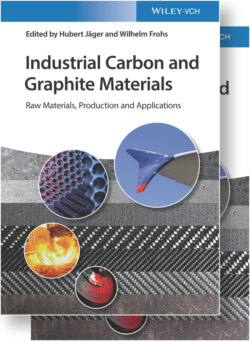Читать книгу Industrial Carbon and Graphite Materials - Группа авторов - Страница 3
List of Tables
Оглавление1 Chapter 2Table 2.1 Physical properties of carbon and its neighbor elements. G=Graphite, D...
2 Chapter 3Table 3.1 Milestones in the history of carbon material.
3 Chapter 5Table 5.1 Properties of diamond and graphite (single crystals) and synthetic gra...Table 5.2 Classification of natural graphite.
4 Chapter 6-1-1Table 6.1.1.1 Typical coke data for various grades.Table 6.1.1.2 Typical pitch properties.
5 Chapter 6-1-2Table 6.1.2.1 Refineries with petroleum coke production 2005.Table 6.1.2.2 Green coke qualities in relation to use.Table 6.1.2.3 Time allotted for different steps in typical 12 and 24 hours cokin...Table 6.1.2.4 Petroleum coke calciners [25].Table 6.1.2.5 World Production of Industrial Carbon 1994.Table 6.1.2.6 Typical range of needle coke types.
6 Chapter 6-1-3Table 6.1.3.1 Production of pitch coke.Table 6.1.3.2 Dimension and operational capacity of typical Koppers coke oven.Table 6.1.3.3 Production of PC by the delayed coking process.Table 6.1.3.4 Variation of the carbon and hydrogen ratio in production steps of ...Table 6.1.3.5 Changes in calcination.Table 6.1.3.6 Physical properties of pitch coke.
7 Chapter 6-1-4Table 6.1.4.1 Typical ash composition.
8 Chapter 6-1-5Table 6.1.5.1 Properties and composition of various tars.Table 6.1.5.2 Properties of coke‐oven tars.Table 6.1.5.3 Important constituents of a typical coke‐oven coal tar.Table 6.1.5.4 Specifications of various electrode pitches from coal tar.Table 6.1.5.5 Specifications of various coal‐tar oils.
9 Chapter 6-2Table 6.2.1 Comparison of open‐ and closed‐top ring furnaces [41,42].
10 Chapter 6-4Table 6.4.1 Typical properties of carbon and graphite products (with grain) at a...Table 6.4.2 Typical thermal‐stress‐resistance factorR (W/m).
11 Chapter 6-5-1Table 6.5.1.1 Voltage drop and anode quality.Table 6.5.1.2 Heat loss breakdown (400 kA cell).Table 6.5.1.3 Al production cost and anode performance.Table 6.5.1.4 Smelter technology and anodes.Table 6.5.1.5 Design data for 800 000 tpy Al.Table 6.5.1.6 Properties of green coke.Table 6.5.1.7 Properties of calcined coke.Table 6.5.1.8 Properties of anode butts.Table 6.5.1.9 Properties of coal tar pitch.Table 6.5.1.10 In‐plant testing.Table 6.5.1.11 Properties of baked anodes.
12 Chapter 6-5-2Table 6.5.2.1 Cathode types.Table 6.5.2.2 Typical ranges of specific electrical resistivity and thermal cond...
13 Chapter 6-5-3Table 6.5.3.1 Typical EAF slag composition.Table 6.5.3.2 Typical figures for an AC furnace with 600 mm electrodes.Table 6.5.3.3 Typical properties of GEs and its connecting pins.Table 6.5.3.4 Steel scrap in million mt for steelmaking in selected countries.
14 Chapter 6-5-5Table 6.5.5.1 Typical values of carbon electrodes.
15 Chapter 6-5-6Table 6.5.6.1 Typical properties of electrode pastes at ambient temperature [dat...
16 Chapter 6-5-7Table 6.5.7.1 Typical physical properties of impervious carbon and graphite mate...
17 Chapter 6-5-8Table 6.5.8.1 Applications of specialty graphites.Table 6.5.8.2 Fields of use for various carbon brushes.
18 Chapter 7Table 7.1 Use of carbon and graphite materials in selected primary battery syste...Table 7.2 Lithium graphite intercalation compounds.Table 7.3 Comparison of anode materials for Li‐ion batteries.Table 7.4 Survey of commercial bipolar plates for use in redox flow batteries.Table 7.5 Survey of typical material properties of carbon felts and RVC.Table 7.6 Selection of experimentally determined rate constants of electrochemic...Table 7.7 Use of carbon and graphite in selected fuel cell systems.Table 7.8 Properties of various commercial bipolar plates.Table 7.9 Typical properties of carbon fiber‐based gas diffusion layer backings ...Table 7.10 Selection of carbon materials used in MPLs and catalysts.Table 7.11 Carbon materials used in electrocatalysts for fuel cells.
19 Chapter 8Table 8.1 Typical reactions catalyzed by carbon‐supported catalysts.Table 8.2 Typical nanocarbon‐catalyzed reactions.Table 8.3 Kinetic parameters for hydrocarbon ODH reactions catalyzed by o‐CNTs a...
20 Chapter 9Table 9.1 Typical dimensions of crystal regions.Table 9.2 Gas‐phase applications and typical data of carbon‐based adsorbents.Table 9.3 Liquid‐phase applications and typical data of carbon‐based adsorbents.Table 9.4 Applications and characteristic data of activated carbon in catalysis.Table 9.5 Typical design data of adsorbers for adsorptive gas and water purifica...Table 9.6 Solvent recovery.Table 9.7 Effect of grain size on the service time of a respirator fitted with a...Table 9.8 Selected application fields for pressure‐swing processes for gas separ...Table 9.9 Commercial grades of impregnated activated carbon.Table 9.10 Regeneration of spent activated carbon.
21 Chapter 10Table 10.1 Crystallographic data of rubber blacks obtained by X‐ray diffraction.Table 10.2 Particle size distribution depending on the production process.Table 10.3 Electrical resistivity of carbon blacks.Table 10.4 Typical data of carbon black feedstock oils.Table 10.5 Summary of the manufacturing processes and feedstocks for the product...Table 10.6 Rubber blacks.Table 10.7 Processing data for high‐performance furnace black reactors.Table 10.8 Composition of the dried tail gas.Table 10.9 Special analytical test methods for carbon black.Table 10.10 Classification of rubber blacks according to ASTM D 1765.Table 10.11 Pigment blacks.
22 Chapter 11Table 11.1 Market share of carbon fibers depending on precursor type.Table 11.2 Comparison of reinforcing fibers for advanced composites.Table 11.3 Comparison of carbon fiber (HT‐type) and carbon fiber (HT‐type)/epoxy...Table 11.4 Required characteristics of precursor fibers for carbon fiber fabrica...Table 11.5 Carbon yield of precursor fibers for carbon fiber fabrication.Table 11.6 Typical chemical compositions of PAN‐based carbon fibers.Table 11.7 Typical physical properties of commercial carbon fibers.Table 11.8 Typical reversible thermal expansion of commercial carbon fibers.Table 11.9 Estimated capacities for pitch‐based carbon fiber (in tons/a).
23 Chapter 12-1Table 12.1.1 Comparison of carbon fiber with steel and with Kevlar and E glass f...Table 12.1.2 Typical design values of laminates.
24 Chapter 12-2Table 12.2.1 Characteristic properties ofhigh tenacity (HT type) and high‐modulu...Table 12.2.2 Characteristic properties of isotropic and anisotropic cellulose‐ a...Table 12.2.3 Characteristic properties of isotropic and anisotropic high‐modulus...Table 12.2.4 Mean free paths of CH4 and H2 as a function of temperature and pres...Table 12.2.5 Characteristic physical data for fabric‐reinforced CFRC with 3k (15...Table 12.2.6 Physical and mechanical data for 3D CFRC [4,98–113].Table 12.2.7 Coefficients of thermal expansion of different carbon fibers [119].Table 12.2.8 Coefficients of thermal expansion of different matrix systems.Table 12.2.9 Surface area (in m2/g) of CFRC after oxidative treatment (5% and 10...Table 12.2.10 Mechanical properties of fabric‐reinforced (2D) and UD reinforced ...
25 Chapter 12-3Table 12.3.1 Properties of industrially produced C/SiC materials based on 2D and...Table 12.3.2 Typical properties of MI‐derived C/C–SiC and C/SiC materials based ...Table 12.3.3 Properties of MI‐derived C/SiC materials based on short fibers comp...
26 Chapter 13Table 13.1 Rodent study reports by the governmental evaluation of CNTs.
